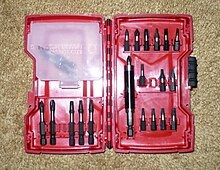Impact driver

An impact driver is a tool that delivers a strong, sudden rotational force and forward thrust. The force can be delivered either by striking with a hammer in the case of manual impact drivers, or mechanically in the case of powered impact drivers.

It is often used by
Manual impact drivers
Manual impact drivers consist of a heavy outer sleeve that surrounds an inner core that is
Powered impact drivers
Typical battery-powered impact drivers are similar to electric drills when used to drive screws or bolts, but additionally have a spring-driven mechanism that applies rotational striking blows once the torque required becomes too great for the motor alone. This should not be confused with the hammer mechanism found on hammer drills, which is a longitudinal blow.[3] Most impact drivers have a handle to make it easier to hold onto. An impact driver is more appropriate than a drill for tightening bolts.
Comparison to an impact wrench
An electric impact driver typically delivers less torque and accepts smaller tool bits than an impact wrench. This makes the impact driver more suitable for driving smaller screws in (for example) construction work, while an impact wrench is preferred in situations requiring more torque to drive larger bolts and nuts (such as lug nuts).
References
- ^ Mayer, Paul. "Impact Driver - Do I really need an Impact Driver?". Woodworkers Guild Of America. Retrieved 2015-09-21.
- ^ "Canadian Inventions – The Robertson Screwdriver System (Peter Robertson)".
Millions of craft workers are thankful to Canadian Peter Robertson for inventing the square-head screw that bears his name. The Robertson screw represented a significant advance in the history of fasteners for two practical reasons: it is self-centering (that is, the screw is almost impossible to be driven off-centre because of the indented squared notch into which the screwdriver fits snugly) and the screw can be driven with only one hand.
- ^ Dahl, Timothy (January 27, 2016). "Cutaway View Shows the Clever Innards That Make an Impact Driver Work". Popular Mechanics.
